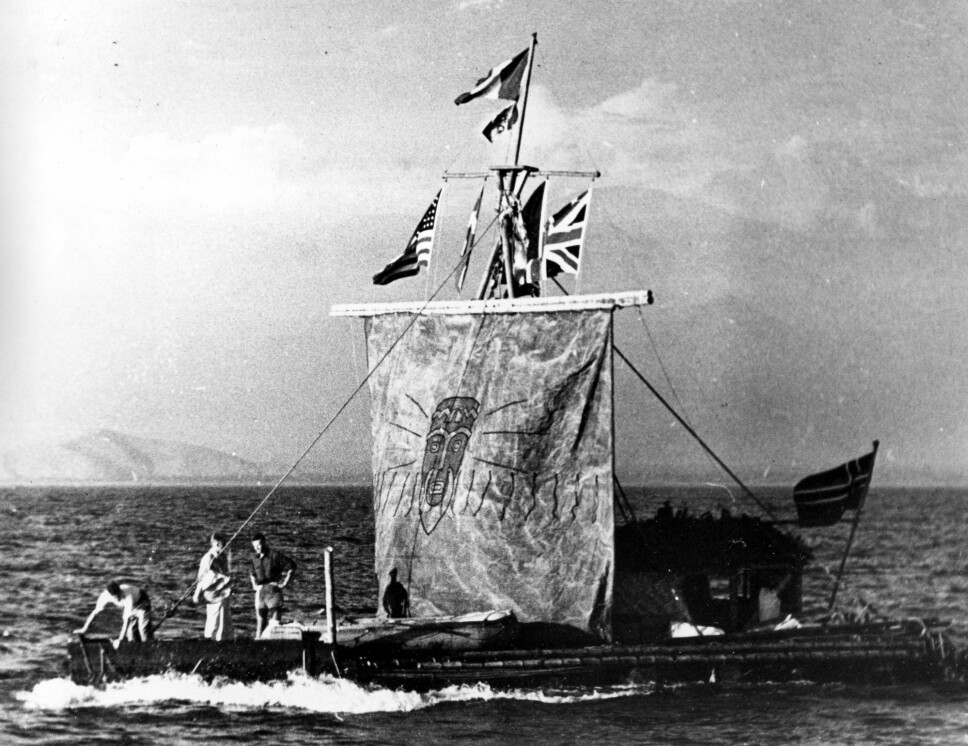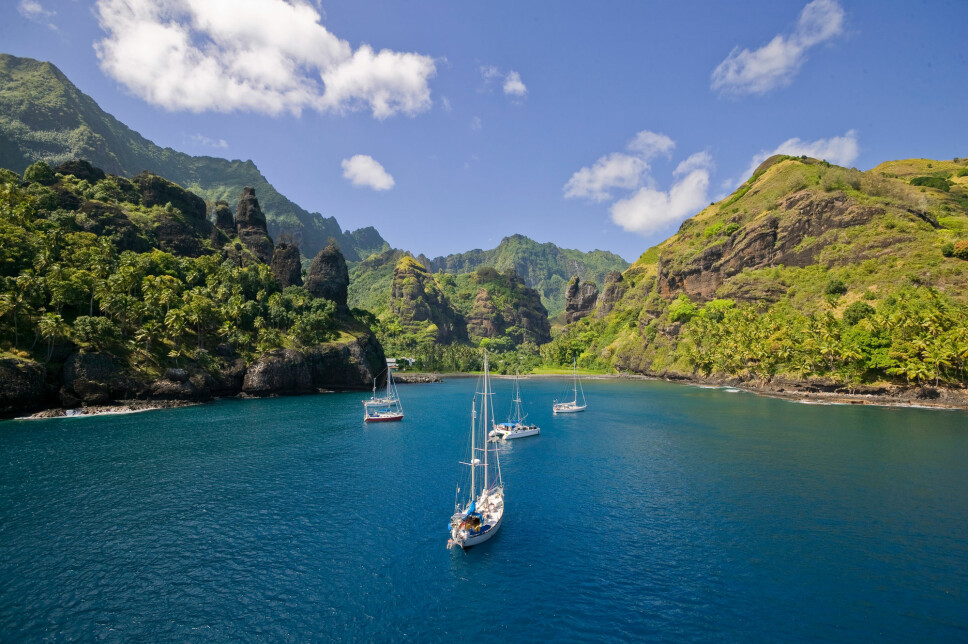
New research supports Thor Heyerdahl's theory on South Americans in the Pacific
There was contact between Polynesia and America long before the arrival of Europeans, a large new DNA study shows. One Norwegian researcher says the new findings are solid.
Did Pacific Islanders and Native Americans ever have contact? This has long been a major question for anthropologists.
When Thor Heyerdahl boarded the Kon-Tiki balsa raft in 1947, he hoped to finally prove that the Pacific islands could have been settled by people from South America, as opposed to the prevailing theory, which was that settlers came from the west.
The introduction of DNA analysis, along with other findings, largely undermined Heyerdahl's theory, and despite the unusual occurrences of South American food plants on the Pacific islands, Heyerdahl's voyage in the end was not much more than an Oscar-winning film and an exciting, if risky, adventure without much scientific value.
Now, 70 years after Heyerdahl's men set out on the open Pacific, an international group of researchers has found clear signs that South American indigenous peoples had contact with Polynesia.
And long before Europeans first saw the white beaches of the islands.
Large DNA set
The researchers started with DNA testing, the same tool that over the years initially helped debunk Heyerdahl's theory.
The research team collected DNA tests from 166 of the Easter Island's indigenous people, as well as from 188 Polynesians from islands across the vast Pacific Ocean. The researchers also analysed DNA taken from large numbers of Native American groups, from tropical Mexico in the north to the cool southernmost part of Chile.
Based on DNA sequences that were characteristic of the various samples, they divided the indigenous peoples into two main groups — a "central" and a "southern" group.
The central group included DNA tests from indigenous groups from Mexico to northern Chile, including groups such as Zapotecs and Aymaras. The southern group covered the indigenous peoples of southern Chile, such as the Mapuche people.
When the researchers examined the DNA samples from the Pacific Ocean, they were surprised to find genetic material from both groups in the native Polynesian islanders from the easternmost Pacific islands.
Independent of European intervention
The important difference is that the gene contribution from the southern American group, mainly discovered on Easter Island, increased in proportion to the genetic material of European origin.
The researchers believe this supports the theory that the American DNA material arrived on the island with Chilean settlers of partly European, partly American descent.
On the other hand, the researchers discovered that the Central American component, which is typical of Mexican and Colombian indigenous peoples, was only associated with the Polynesian part of the genetic material.
This suggests that the genetic material came to the islands independently of the European and southernmost American material.
In fact, the researchers' find suggests that this introduction took place several centuries before European ships first sailed into the Pacific Ocean.
Researchers also discovered DNA sequences from the Central American group in other distant Pacific islands, such as the Marquesas Islands, Palliser and Mangareva.
Colombia, not Peru
When the researchers investigated the origin of these genes, they found a close match with the Zeno people in present-day Colombia.
The researchers note that their findings are in line with a number of linguistic, historical and geographical clues that support contact with northern South America.
Among these are apparent similarities in pre-Columbian stone statues on the easternmost Pacific islands. Even more convincing for researchers is the Polynesian word for sweet potato, kumala.

This vegetable originated in northern South America, and, the researchers write, is known to the Cañari people in Ecuador as cumal.
Heyerdahl suggested present-day Peru as the probable origin of this overseas contact, but the Peruvian indigenous peoples who use related names for the plant are located in the highlands, far from the coast. The researchers behind the new DNA study suggest that the origins of the contact came from areas further north.
In support of their theory, the researchers note that there are forests suitable for boat building north of the barren Peruvian coast, in Ecuador and Colombia.
And it is from this coastal area that people are said to have embarked on trade voyages to Mesoamerica in large sail-powered balsa boats during the times before Columbus' arrival and the subsequent collapse of society.
The researchers also point out that the way the winds and currents run in this area of the Pacific make it most likely prehistoric sailors from this region would drift to Polynesia.
Peru, on the other hand, is so unfavourable in terms of winds and currents that Heyerdahl's Kon-Tiki had to be towed miles off the coast before the wind finally took hold and carried the boat to Tuamotu.
One meeting
The researchers concluded that there was one incident of contact between these separate ethnic groups.
Since different population groups have different DNA sequences, and since DNA sequences become shorter the longer they have been part of the genetic material, the researchers were able to estimate approximately when the introduction took place by measuring the length of the sequences.
By tracking the earliest time estimates, researchers have also proposed the most likely meeting places. Starting with the South Marquesas Islands in 1150, the timeline looks like this: Northern Marquesas in 1200, Palliser and Mangareva in 1230. Finally, the mixed population arrives at Rapa Nui — better known as Easter Island.
Presumably, these South American genes spread to the Polynesian people on one hitherto unidentified island before the mixed Polynesians continued their voyages of discovery and colonization in the far Pacific.
As a result, the researchers concluded that previous studies have looked in the wrong place, at the complicated case of Easter Island, and that the American heritage of the Rapa Nui people originated before the ancestors of Easter Islanders had set foot on the island.
The researchers believe this can also explain how the sweet potato ended up on Easter Island. The settlers would have brought the plant with them, in as much as the isolated island was populated via a one-way ticket that ended in geographical isolation.
Heyerdahl's theory
Erik Thorsby is a medical doctor and professor at the University of Oslo who has studied the origins of the Easter Islanders. It was his research group that more than a decade ago discovered the first genetic evidence for early genetic contributions from Native Americans on Easter Island.
This new study is completely independent of Thorsby's research, and he told sciencenorway.no that he thinks it's fun that this new article confirms his group’s findings.
“But what’s new about this article is that they studied many other islands, and found evidence that the first contact between Native Americans and Polynesians didn’t happen on Easter Island, but perhaps on some other Polynesian island,” Thorsby said.
As early as 1952, Heyerdahl suggested that the first people to inhabit the eastern part of Polynesia were Native American peoples, but the controversial theory was heavily criticized because of insufficient evidence. Later, researchers conducted many genetic studies that ultimately discredited Heyerdahl's idea.
"That was the situation until about ten years ago, when we used modern DNA technology to find the first evidence that there had been an early genetic contribution from Native Americans in Polynesia," Thorsby said.
“So you can say that we had some of the first evidence that Thor Heyerdahl's theory was not completely wrong,” he said.
Did the South Americans come first?
The earliest date the researchers were able to establish was 1150 for the island of Fatu-Hiva, the southernmost of the Marquesas Islands.
“And the interesting thing here is that Fatu-Hiva was the first island Thor Heyerdahl visited. He was on a honeymoon with his wife Liv in 1937–38, and it was there that he found the first signs that he thought indicated there had been early contact between South America and Polynesians,” Thorsby said. “So that’s a very interesting and fun part of this new research in regards Thor Heyerdahl's theory.”

What is also startling about the researchers' findings is that the first hereditary evidence for Native American people’s contact is dated to about the same time as historians have said that Polynesians discovered the island.
In other words, the Polynesian explorers may have for the first time encountered a populated island, and found an established community of American settlers.
“And that is exactly what is at the core of Thor Heyerdahl's theory. He believed Native Americans inhabited Polynesia before the Polynesians came from the west,” Thorsby said.
Could there be other explanations?
An earlier explanation for the partly Native American origins of Easter Island's indigenous peoples was a Peruvian slave expedition in 1862–63. Following international condemnation, a return trip was organized for the several thousand Pacific residents who had been abducted, but due to illness, among other things, few of the unfortunate captives returned to their home islands.
Only two of the islands in the researchers' datasets welcomed these people, including Easter Island. Since the captives had been held only a few months, the researchers believe it is unlikely that this stay contributed to the American DNA sequences found on the islands.
In any case, the researchers wrote, the origin of the genes lies in islands unaffected by this voyage, and north of the Peruvian indigenous peoples that the researchers also looked at for the study.
What the researchers can’t rule out, however, is that the Polynesians travelled to South America, rather than the other way around. Voyagers on this journey might have returned home either with new friendships or genetic material in their luggage.
This would have taken place during the period when scientists dated the arrival of genes to the Pacific Ocean, which is when the Polynesians' most intense voyages of discovery took place, and when the most distant islands in the Pacific Ocean were populated for the first time.
Skeletal DNA
Thorsby says that the data presented by the research group are solid, and he expects their research will attract a great deal of attention.
“But these data must be confirmed, because there is so much here that’s new. We will need recent studies of other samples. It would also be good to have DNA from old skeletons — or what is called ancient DNA. But it is very difficult to get permission to extract these samples from human remains,” he said.
He says that the studies from his research group also attracted some attention, but that no one was able to confirm their findings.
“But this article fully confirms the studies we did twelve to fifteen years ago, plus it introduces much new information,” he said.
Translated by: Nancy Bazilchuk
Reference:
Alexander G. Ioannidi et al.: Native American gene flow into Polynesia predating Easter Island settlement, Nature, July 2020
———
Read the Norwegian version of this article on forskning.no






























